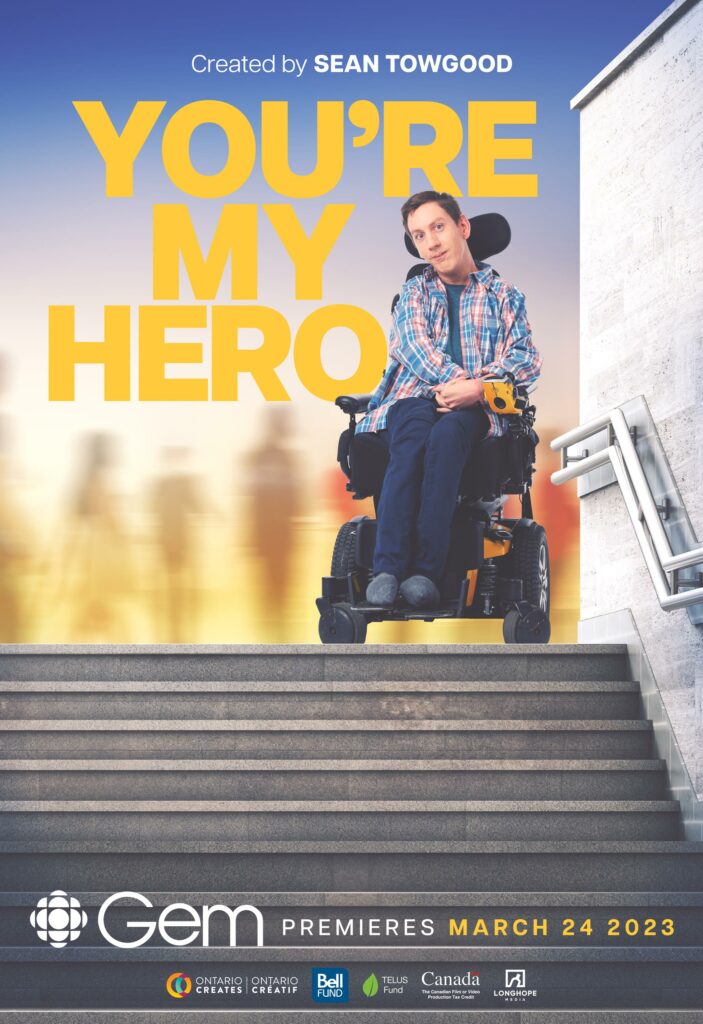
YOU’RE MY HERO is a seven part, fifteen minute series on CBC Gem created by and starring Sean Towgood, who plays the lead character, Ian. Ian, a blunt unfiltered 20-something with cerebral palsy, navigates the social pressures of life in an unforgiving world not designed for wheels.
The show’s budget was shot under Tier D New Media with ACTRA, WGC, and non union crew. They filmed 7-10 pages per day.
ACTRA spoke with the Producer of You’re My Hero, Meghan Hood, to learn about how they were able to successfully meet the accessibility needs of the cast despite their low budget. This webpage outlines the learnings from our conversation with Meghan.
Key Learnings:
Overall, Production felt that this was less of a logistical lift than initially thought. The key to this was thinking ahead and anticipating potential challenges to allow sufficient time to find a solution. They recognized that it was the last-minute problems that would cost time and money, so did everything possible to avoid them. Consultation played a key factor in helping the Production plan to successfully meet the accessibility requirements of the cast. Out of the entire budget, accommodations accounted for under $10,000 (including furniture, additional location supplies, specialized vehicles, overnight accommodations etc) – or 1.2% of the total budget.
Pre-Production:
Location Scouting:
- Sean, the creator has cerebral palsy. Production had to be shaped around this. Originally, it was assumed they would be shooting more on location, but when they realized how many accessibility challenges this would pose, they decided to look for a studio location instead. They built standing sets in Knoll Studios in Oakville, which was more practical as they could repurpose some of those sets in future.
- The building where the set was built was single level, had ramps, an accessible walkway, and many entrances. This would prove helpful for both cast using mobility devices, as well as for the camera/lighting/grip departments who would need to wheel in their gear.
- The production was thoughtful of what would be needed on set and prepared/built ahead rather than trying to retrofit a space without these considerations.
- Sean was included in the location scouting. He was able to point to issues like furniture being too low. Production bought inexpensive risers from Home Depot to be able to raise furniture as needed on set and kept extras on hand. This was a cheap solution that resulted in saving time later on for camera setups.
Wardrobe:
- Production was block shooting, meaning that Sean might be in 4 different outfits in one day. There was a conversation with Sean and the costume designer, and it was decided only his socks and shirt would be changed, to avoid the more time consuming process of changing his pants. This saved time and avoided a cumbersome and tiring process for Sean.
Casting:
- Sean was instrumental in casting because he has ties to the community.
- Casting was done through self-tapes, with accommodations provided if required.
- As soon as cast was booked, production asked about any accommodations that may be required for performers. It was never assumed that everyone had the same level of access.
- There was one role where Production was seeking a performer who is hard of hearing or Deaf. When they were unable to find the right performer for this role though usual casting methods, they reached out to a local theatre company who featured performers from the Deaf community in the past, and permitted the performer.
Production:
Call Sheets:
- Information was included on the call sheets to clearly communicate the expectations of the Production to the crew and practical information for all cast and crew. For example, the location of accessible washrooms, the need to keep pathways and entryways clear, designated accessible spaces in holding, etc.
Location Safety:
- Production ensured hallways and pathways were always clear, as cluttered hallways are a fire hazard and pose barriers for folks using mobility devices. A crew member was assigned the job of checking after every set shift to ensure hallways and pathways remained clear and accessible.
- Cable mats were always used. Cables were taped down to ensure they were safely secured and would not be tripping hazards and could be easily wheeled over.
Transportation:
- Special care was taken to ensure that performers had the correct transportation access to set – i.e. are they able to travel in the standard transport van, or did they require specialized transportation?
- Sean required specialized transportation to ensure that his chair would fit in the vehicle in which he was travelling. His mother is an ACTRA member, and her vehicle was already fully outfitted to accommodate his needs. The Producer decided to cast his mother in the show as his PSW, and paid her a vehicle rental fee for transporting him to and from set.
- Despite falling within the 40km radius, transportation was arranged for all cast. There were two drivers on set with production vehicles, or Taxis/Ubers were reimbursed as required. This helped remove the barrier of performers needing to take public transit to set, as not all public transit is fully accessible, and the lengthy commute would add several hours to the day of each performer, tiring them out.
Shooting Schedule:
- Shooting days were scheduled for 11+1 (instead of 12+ 1) to help avoid burn-out for both the cast and crew. Since Sean was scheduled for almost every single day of shooting, he was scheduled in a way so that he would be brought in as late as possible, and would be given as many breaks as they could.
- When there were performers on set that needed an accommodation regarding the length of hours worked in a day, production would ensure that the schedule was adjusted to prioritize these performers.
- Scene order would be adjusted to prioritize the well-being of the cast as opposed to what might normally be easier for the crew. For example, the crew might do an extra move so that Sean would not have to change his wardrobe twice.
- Representation: the show showed a PSW helping Ian, Sean’s character.
Dressing Rooms:
- Due to Sean being scheduled for nearly every shoot day, he was provided with a dedicated dressing room (all other cast had private changing areas + holding). A double bed from Ikea was purchased by Production and placed in his dressing room so that he could rest in between scenes where he was not needed, to help avoid fatigue. The bed was stored after wrap for future Production use.
Overnight Accommodations:
- Due to Sean being scheduled for nearly every shoot day, and living over an hour away from the shooting location, instead of having him commute to set every day, Production put him and his mother up at a nearby hotel that was fully wheelchair accessible.

